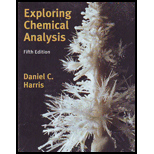
(a)
Interpretation:
Requirement of high pressure in HPLC has to be explained.
Concept Introduction:
High performance liquid chromatography in analytical chemistry is an important technique for the separation, identification, and quantification of analyte. Previously high-performance liquid chromatography was known as high-pressure liquid chromatography.
(b)
Interpretation:
Reason behind the increase in efficiency of liquid chromatography with decrease in particle size of the stationary phase has to be explained.
Concept Introduction:
Plate height can be calculated by van Deemter equation as follows:
Here
The term
The term
The term
Plate height is inversely proportional to the efficiency of the chromatographic separation.
(b)
Interpretation:
Advantages and disadvantages of UPLC have to be explained.
Concept Introduction:
Ultra performance liquid chromatography is a modification over HPLC. It is applicable for particles with less than
(d)
Interpretation:
Advantages of the use of superficially porous particle has to be written.
Concept Introduction:
In superficially porous particle chromatography, stationary phase diffuses into fully porous particles with a radius of
Want to see the full answer?
Check out a sample textbook solution
Chapter 22 Solutions
Exploring Chemical Analysis
 ChemistryChemistryISBN:9781305957404Author:Steven S. Zumdahl, Susan A. Zumdahl, Donald J. DeCostePublisher:Cengage Learning
ChemistryChemistryISBN:9781305957404Author:Steven S. Zumdahl, Susan A. Zumdahl, Donald J. DeCostePublisher:Cengage Learning ChemistryChemistryISBN:9781259911156Author:Raymond Chang Dr., Jason Overby ProfessorPublisher:McGraw-Hill Education
ChemistryChemistryISBN:9781259911156Author:Raymond Chang Dr., Jason Overby ProfessorPublisher:McGraw-Hill Education Principles of Instrumental AnalysisChemistryISBN:9781305577213Author:Douglas A. Skoog, F. James Holler, Stanley R. CrouchPublisher:Cengage Learning
Principles of Instrumental AnalysisChemistryISBN:9781305577213Author:Douglas A. Skoog, F. James Holler, Stanley R. CrouchPublisher:Cengage Learning Organic ChemistryChemistryISBN:9780078021558Author:Janice Gorzynski Smith Dr.Publisher:McGraw-Hill Education
Organic ChemistryChemistryISBN:9780078021558Author:Janice Gorzynski Smith Dr.Publisher:McGraw-Hill Education Chemistry: Principles and ReactionsChemistryISBN:9781305079373Author:William L. Masterton, Cecile N. HurleyPublisher:Cengage Learning
Chemistry: Principles and ReactionsChemistryISBN:9781305079373Author:William L. Masterton, Cecile N. HurleyPublisher:Cengage Learning Elementary Principles of Chemical Processes, Bind...ChemistryISBN:9781118431221Author:Richard M. Felder, Ronald W. Rousseau, Lisa G. BullardPublisher:WILEY
Elementary Principles of Chemical Processes, Bind...ChemistryISBN:9781118431221Author:Richard M. Felder, Ronald W. Rousseau, Lisa G. BullardPublisher:WILEY





